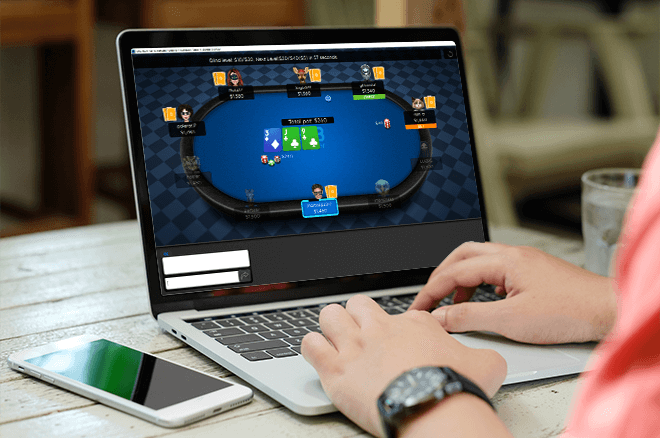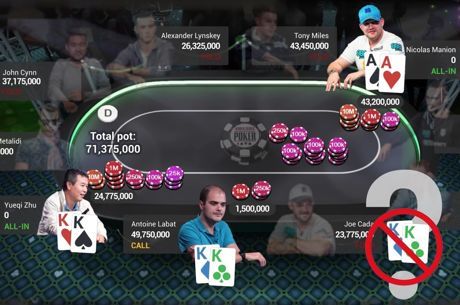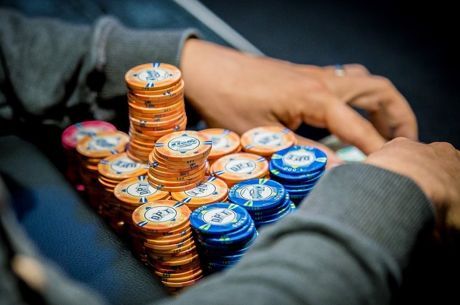Hand Analysis: When the Risk Ain't Worth the Reward

Every bet is an effort to win the pot in front of you. The size of that bet is the degree of exertion behind that effort. In general, you should not try harder than necessary.
Even so, many players, looking for an alternative to the difficulty of muddling through the many possibilities, will choose the biggest possible bet, as if to say loudly, "I want this pot to be mine." Often enough in such circumstances, poker proves a good teacher to correct such thinking.
Here's an online hand of six-handed 100NL that provides just such a lesson �� one in which a player makes a huge overbet and learns the hard way why he shouldn't have made the effort.
Small Stuff, Then a Sudden Shove
This instructive pot began simply enough, with a min-raise to $2 from an inexperienced player sitting under the gun. A big-stacked regular who had been cleaning up as usual flat-called from the cutoff seat, and despite the attractive price everyone else folded.
The flop fell 6?5?3? and the initial raiser checked. The cutoff player bet just under half-pot and the UTG player called, making the pot $10.72.
The turn was the 5?, pairing the board and bringing a flush draw.
Generally speaking (or rather, in most cases), the board is not too likely to have hit either player given the preflop action and their positions. All other things being equal, UTG should have a bit of a range advantage.
Of course, after the flop action (check-bet-call), not everything was equal. Our inexperienced player, sitting under the gun and out of position, looks like he has high cards that missed but he doesn't quite want to give up them on yet. The player in the cutoff, meanwhile, probably makes a stab with just about every hand he has in his range.
On the turn there was another check, another rather meek-looking bet of $5, and a wild overreaction �� an all-in shove by the UTG player for almost $123 effective (!).
A Bit of Counting
At this point, it is worth calculating the risk and the reward.
After the cutoff makes his turn bet, there only a little under $16 out there. Meanwhile the amount being risked by the UTG player is nearly 8 times that.
The cutoff can have the nuts �� hands like 6-6, 5-5, 3-3, and perhaps the two 6-5s combinations (spades and clubs). That would add up to 9 combinations.
Let's hastily assume that the times the cutoff calls this huge check-raise, he has one of these 9 combinations and he folds everything else. That means the UTG's move would need to fold out something like 75 combinations from his opponent's turn betting range, just to break even. That's a bit of a challenge.
For instance, pairs 7-7 through Q-Q add up to 36 combinations total. A-Q represents another 16 combinations (but would A-Q really always bet this way, and would A?Q? fold?). Between 8-7s, 9-8s, T-9s, J-Ts, Q-Js, K-Js, A-Ts, K-Qs, and A-Js, we have another 36 combinations.
So it is possible to get there, but the cutoff needs to be betting $5 a lot of the time and folding a lot of the time thereafter. Why would he bet A-Q at all, anyway?
The Risk of Running Into It
The point of this digression is that the cutoff in fact had 6?6? for a full house, and of course called right away.
If UTG had been playing a pocket pair this way (7-7 or higher), the best he could do would be to have two outs versus his opponent's strongest calling range. He didn't even have that, though, as he had made his big push with 10?8? for what turned out to be a useless flush draw.
Setting aside the massive bankroll hit caused by the blunder, let's go back to that original point about the need to make less "effort" (i.e., by betting less) when you can in order to pick up pots. Could UTG have bet less here and still folded out the same hands? One would expect to get many folds from a raise to $18 (let's say) from hands that also fold to nearly $123. And when the smaller raise is called the chance of having live outs goes up.
We might think of this play as better done with T-2o than with 10?8?, because once we risk this amount of money, we are drawing dead when called and our hand does not matter anymore. That is perhaps a bit counterintuitive �� to want less "backup" when risking more and more equity when risking less. But that's the nature of this board and situation.
There are other benefits to making a different size of check-raise here (why not $28, by the way? it doesn't have to be to $18). With smaller raises, your opponent can put more money in the pot on the turn and then fold on the river. Or even pay off the river, should you improve.
Raising less means there are more decisions to be made, and more possibilities to win money. That would be a better way to exert one's effort, actually. It would also ensure a better balance between risk and reward.









